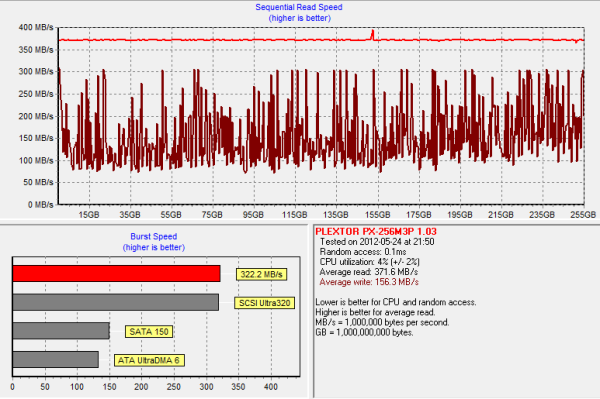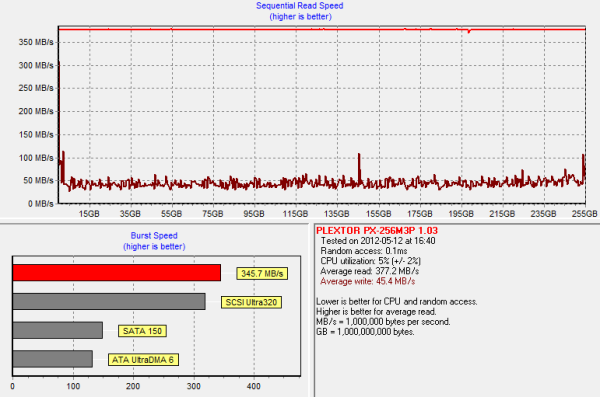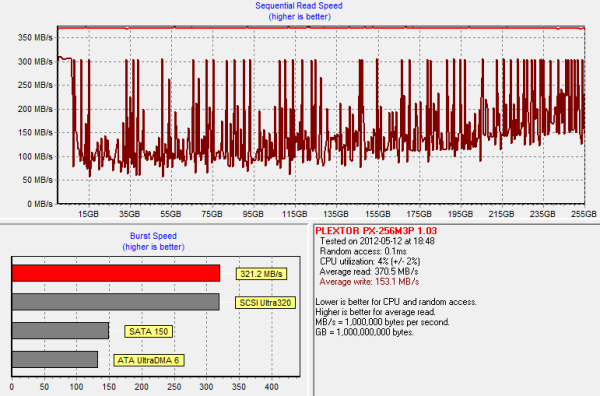Plextor M3 Pro (256GB) Review
by Kristian Vättö on July 1, 2012 1:45 PM ESTPerformance Over Time and TRIM
The M3 Pro is also equipped with Plextor's "True Speed" technology, which we found to be fairly effective when testing the M3. Hence we should expect the M3 Pro to do well in this aspect as well. To get the base-level performance, I ran HD Tach once on a clean drive:
The first step in our torture testing is 20 minutes of 4KB random writes (QD=32, 100% LBA space) ran on a full drive:
As with the M3, 20 minutes of torturing is nowhere enough to put the M3 Pro at its worst state. The average write performance is still 156MB/s, although it does drop to as low as 70-80MB/s for some LBAs.
Next I secure erased the drive and ran our torture test for 60 minutes:
And that's more like it. Average performance has dropped to 45MB/s and there are only three +100MB/s peaks. This was expected as the M3 experienced similar behavior.
I let the drive idle for an hour and 40 minutes after 60 minutes of torture and a single pass of HD Tach, and here's what the performance looked like:
Performance does recover pretty nicely with some idle time and sequential writes. Write speed is still nowhere near clean state performance but it has more than tripled when compared to the dirty state after 60 minutes of torturing.
Finally I TRIM'ed the drive to make sure that TRIM functions properly, and it does:
Overall the M3 Pro should be a good option, even if you're using an OS without official TRIM support (such as OS X). If you're running an OS with TRIM support, then there is obviously nothing to worry about as TRIM functions perfectly. TRIM can nowadays be enabled in OS X for third party drives as well, so there is even less to worry about. If you don't want to have TRIM enabled all the time (due to stability issues for example), you can enable it temporarily and TRIM the drive by secure erasing free space in Disk Utility. After that you can simply disable TRIM and you are left with a TRIM'ed SSD.















55 Comments
View All Comments
Coup27 - Sunday, July 1, 2012 - link
I agree. I welcome another SSD toolbox into the mix, but with its current feature set, it is largely pointless. Manual TRIM for a toolbox utility is essential.I presume that Samsung make Toshiba's NAND for them? I did not know that.
Kristian Vättö - Sunday, July 1, 2012 - link
Samsung and Toshiba both make their own NAND. Toshiba does have a joint venture with SanDisk though (similar to what Intel and Micron are doing).Coup27 - Monday, July 2, 2012 - link
"The NAND is once again from Toshiba and there are a total of eight NAND packages on the PCB. These are 32GiB quad-die packages and are manufactured using Samsung's 24nm process"I don't understand this then?
Kristian Vättö - Monday, July 2, 2012 - link
That's a typo/error. Fixed now :-)csroc - Sunday, July 1, 2012 - link
At least the author knows who Plextor is this time!pheadland - Sunday, July 1, 2012 - link
OCZ also has an SSD toolbox, and it more functionality than the Plextor one.Belard - Monday, July 2, 2012 - link
Last time I checked... its just a ROM/FIRMWARE upgrade tool.Hence, I buy and tell friends to get Intel drives. I'll gladly pay the extra $20~30 for the reliability, support and upper-class performance. Sure its NOT #1, but I'll take a slight performance hit over BSODs and full out failures.
I had to explain to a client his SSD that Dell installed in his high end Dell is a Samsung that doesn't support TRIM... its new enough to be SATA3/6Gbs - and yet its performance is already SLOWER than my own intel G2 M25 drive (SATA 2).
The Intel tool box if full featured. 3.0x is quite nice.
KAlmquist - Sunday, July 1, 2012 - link
I ask because the write performance of SSD's can vary a lot depending on how full the drive is. The Vertex 4 even uses a different block allocation algorithm if the drive is less than half full.Kristian Vättö - Sunday, July 1, 2012 - link
Storage Bench is run on a clean drive.KAlmquist - Monday, July 2, 2012 - link
So it measures how the drives perform when they have a lot of free space. Thanks.